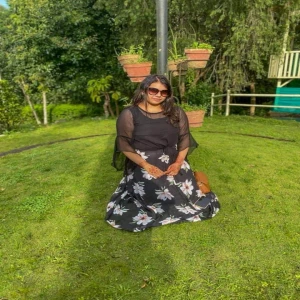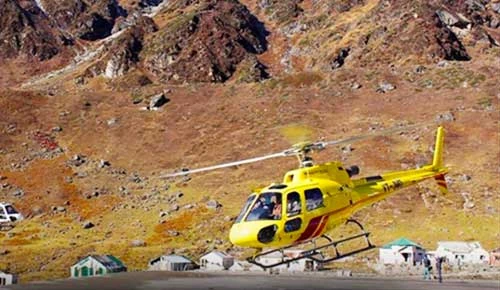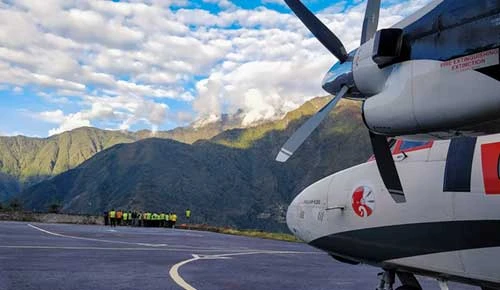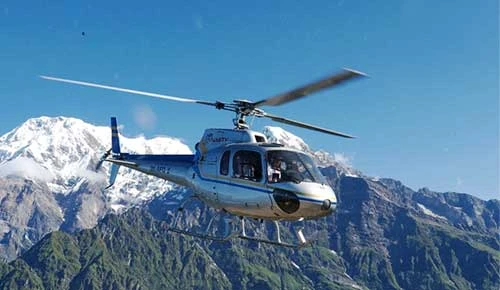Shey Phoksundo National Park
Shey Phoksundo National Park lies in the Dolpo region, which is a monument to the Himalayan region's natural beauty and biological diversity.
This national park, which covers an area of about 3,555 square kilometers, is home to a variety of environments, including lush forests and high-altitude desert plateaus. The park's most famous feature is Phoksundo Lake.
With many uncommon and endangered species, the park is well known for its distinctive biodiversity. Its inhabitants include the elusive Tibetan wolf, musk deer, Himalayan blue sheep, and snow leopards.
Enthusiasts of birds swarm the park to view its feathered beauties, which include the endangered white-rumped vulture, the magnificent griffon vulture, and the Impeyan pheasant.
Shey Phoksundo National Park shares a rich cultural heritage with the Bonpo and Tibetan populations that have lived in the area for many years. Their customs, such as livestock trade and yak herding, continue to influence the topography and add to the rich historical tapestry of the park.
Shey Phoksundo's rough paths entice hikers and explorers with their unmatched possibilities to discover secluded valleys, historic monasteries, and stunning scenery.
Essential Information for Shey Phoksundo National Park
Feature | Information |
Area | 3,555 km² |
Location | Dolpa and Mugu Districts, Mid-Western Region, Nepal |
Buffer Zone | 1,349 km² surrounding the park |
UNESCO World Heritage Site | No |
Established Date | 1984 |
Number of Species | Over 1,000 plant and animal species |
Activities | Trekking, camping, bird watching, and cultural experiences |
Key Attraction | Phoksundo Lake (deepest lake in Nepal, turquoise colored) |
Entry Fees | Foreigners: NPR 3,000 (approx. USD 24), SAARC Nationals: NPR 1,000 (approx. USD 8) |
Table of Contents
History of Shey Phoksundo National Park
When it was first created in 1984, this park was known as Shey Phoksundo Wildlife Reserve. In 1993, it received the designation of a national park. The park was established with the intention of safeguarding the region's delicate ecosystems and distinctive biodiversity.
The name of the park is derived from two notable features: Phoksundo Lake, the deepest lake in Nepal and a major draw for visitors, and Shey Monastery, a centuries-old Buddhist monastery situated inside the park's limits.
The native Tibetan and Bonpo people have inhabited the area for many centuries, and the region has a long history of human occupancy. Their customs, which include transhumance and yak herding, have molded the terrain and added to the region's cultural value.
Shey Phoksundo National Park has had several difficulties over the years, such as poaching, illicit logging, and disputes between the demands of the surrounding population and animal protection.
Community-based conservation programs, integrating local communities in park management, and encouraging sustainable lifestyles that align with conservation objectives have all been used to try to solve these problems.
Shey Phoksundo National Park is a living example of Nepal's dedication to protecting its rich natural history and diverse cultural legacy. People from all over the world still love to visit this park because it has beautiful views, lots of animals, and a unique history.
The park makes an effort to guarantee that future generations are able to recognize and enjoy its natural beauty and ecological significance through continuous conservation efforts and sustainable tourism practices.
Flora and Fauna of Shey Phoksundo National Park
Shey Phoksundo National Park is home to diverse flora and fauna. Here is detailed information regarding the flora and fauna of Shey Phoksundo National Park.
Flora
- Alpine Meadows: The park's expansive alpine meadows are covered in vibrant wildflowers like edelweiss, gentians, and primroses, which combine to create a stunning scene.
- Rhododendrons: Throughout the spring, a variety of rhododendron species lend vivid hues to the slopes, enhancing the park's natural beauty.
- Juniper Forests: The majority of juniper forests in the park's lower altitudes support a diverse range of fauna and contribute to its distinct ecology.
- Blue Pine and Spruce: These woods, which make up a large percentage of the park's lower valleys, are home to a variety of plant and animal species.
- Medicinal Plants: The park is abundant in medicinal plants that have historically been employed for a variety of reasons by the local population, underscoring the significance of its biodiversity in conventional medical procedures.
Fauna
- Snow Leopard: One of the most important habitats for the elusive snow leopard, an apex predator in the area and a symbol of the Himalayan wildness, is Shey Phoksundo National Park.
- Himalayan Blue Sheep: Frequently observed in the park's rough terrain, these quick and sure-footed creatures provide an essential supply of prey for predators like snow leopards and Tibetan wolves.
- Musk Deer: The park is home to musk deer, who have historically been the focus of poaching due to their prized musk glands.
- Tibetan Wolf: The Tibetan wolf, a highly adapted predator that is essential to preserving the equilibrium of the environment, lives in the park.
- The Himalayan Griffon Vulture: This is a unique type of vulture that soars far above the mountains and maintains the ecological integrity of the park by feeding on carrion.
- Impeyan Pheasant: Found in the park's woodlands and meadows, this vibrant bird is also referred to as the Danphe in Nepal. It is the nation's national bird.
Activities to do in Shey Phoksundo National Park
A variety of activities are available at Shey Phoksundo National Park for tourists who want to fully experience the park's natural beauty and cultural legacy. The following are a few things to do at the park:
Trekking: The park has an extensive system of beautiful routes that travel through a variety of environments, including lush woods and plateaus at high altitudes. Multi-day treks are available for hikers, such as the well-known trek to Phoksundo Lake and the Upper Dolpo Trek, which provide stunning views of the surrounding Himalayan peaks.
Seeing Wildlife: To see a range of animals, including snow leopards, Himalayan blue sheep, musk deer, and several bird species, visitors can take guided tours or simply stroll the park's paths. The best times to see animals are in the early morning and late afternoon.
Birdwatching: With over 200 kinds of birds identified within its borders, Shey Phoksundo National Park is a birdwatcher's paradise.
Cultural Exploration: Visit the traditional Tibetan and Bonpo villages strewn around the park to learn more about the rich cultural legacy of the area. Discover the distinct lifestyle of the surrounding people, see historic monasteries like Shey Gompa, and take in customs like yak herding and prayer rites.
Camping: Those who enjoy camping can set up their tents encircled by the peace of the Himalayan scenery. A wonderful experience is camping next to Phoksundo Lake among the stars.
Photography: With its breathtaking scenery, varied fauna, and energetic cultural settings, the park provides plenty of photographic opportunities.
Nature Walks: Enjoy the sights and sounds of the Himalayan countryside by taking strolls along the park's nature paths. Informative hikes with expert guides provide a better understanding of the vegetation, animals, and ecology of the park.
Villages near Shey Phoksundo National Park
Several settlements in Shey Phoksundo National Park, home to indigenous Bonpo and Tibetan people, provide a window into the customs of the Himalayan area. Among the well-known settlements close to the park are:
Ringmo: Ringmo is a charming town on the banks of Phoksundo Lake and is renowned for both its breathtaking natural beauty and its traditional Tibetan culture. This town is located above the lake and provides sweeping views of the surrounding countryside. The centuries-old Buddhist monastery known as the Ringmo Monastery is located in the settlement.
Saldang: Saldang is one of the biggest settlements in the area and a center for trade and business, is situated in the upper Dolpo region. The community is distinguished for its historic stone homes, barley fields, and various centuries-old monasteries, such as the centuries-old Saldang Monastery.
Tshowa: Tshowa is a little village with a serene location amid the rough Himalayan landscape, and it is located along the route to Phoksundo Lake. Explore the village's winding lanes, talk to the residents, and see customs like butter lamp offerings at the nearby monasteries and yak herding.
Palam: Palam is a small settlement in the upper Dolpo area, which can either be reached through hiking or horseback riding. The community is well-known for its historic Bonpo monasteries, one of which is thought to be the oldest in the area, the Palam Monastery.
Dho Tarap: Dho Tarap is a picturesque town located in the Tarap Valley. The community is well known for its rich cultural legacy, which includes traditional stone homes with elaborate wood carvings and vibrant prayer flags that billow in the breeze.
Entry Fees for Shey Phoksundo National Park
Please find the breakdown of the entry fees below:
- Foreigners Entry Fee: NPR 3,000 (approximately USD 24)
- SAARC Nationals Entry Fee: NPR 1,500 (approximately USD 12)
- Nepali Nationals Entry Fee: NPR 100 (approximately USD 0.80)
Important Policies while visiting Shey Phoksundo National Park
- Permits: It is required to have the appropriate permits to access the national park. This covers the entrance pass as well as any additional permits needed for certain activities like hiking or camping.
- Respect Wildlife: Keep a safe distance from animals and avoid feeding or petting them. Don't interfere with their environment or natural behavior.
- Leave No Trace: Reduce your environmental effects to uphold the Leave No Trace philosophy. Remove all trash and properly dispose of waste. Be mindful of the assigned camping zones and refrain from uprooting trees.
- Cultural Sensitivity: Show consideration for the customs and heritage of the nearby indigenous populations. Before visiting any communities or places of worship, get permission and dress respectfully.
- Remain on designated paths: Stay on recognized paths to protect delicate ecosystems and reduce the chance of getting lost. To ensure your safety and the preservation of the ecosystem, abide by the park's rules and signage.
- Responsible Photography: Take pictures with an awareness of the natural world and the animals that inhabit it. Keep in mind the rules for ethical wildlife photography and refrain from upsetting animals only to get a good shot.
Wonders of Shey Phoksundo National Park
In summary, Shey Phoksundo National Park offers a unique combination of magnificent landscapes, abundant wildlife, and an old cultural legacy, perfectly capturing the natural grandeur of the Himalayas.
It entices travelers to experience its rough paths, spot elusive species, and become enmeshed in the customs of native tribes. Let's adopt ethical travel habits as guardians of this precious nature to guarantee its preservation for future generations.
Shey Phoksundo is more than simply a place to visit; it's a sanctuary where the majesty of nature and the spirit of humanity collide, creating a lasting impression on everyone who enters its domain.








